Week 20th – 26th May 2013
Here is this weeks Mystery Creature! A lovely colourful animal, don’t you think…but what is it?
 |
| photo credit: PacificKlaus via photopin cc |
Science, Curiosity and Life
Week 20th – 26th May 2013
Here is this weeks Mystery Creature! A lovely colourful animal, don’t you think…but what is it?
 |
| photo credit: PacificKlaus via photopin cc |
Week 13th – 19th May 2013
How did you do with this week’s mystery creature? Did you like the little twist this week… can you name this EGG? So what common back garden bird laid these eggs?…
| This week’s mystery creature… robin eggs! |
It was a Robin! These six beautiful speckled eggs were laid by a robin right outside my kitchen window. I have been charmed watching her gather the nest materials and then “sitting casually” on the fennel plant to distract any threatening on watchers of her ultimate path to her new home. She prepared her nest on the ground alongside my herb garden, in a clump of scutch grass. As we do not wish to disturb this nest in any way the possibility of grass cutting or weeding in that area of the garden has been put on hold…. can you hear my husband’s sigh of relief?
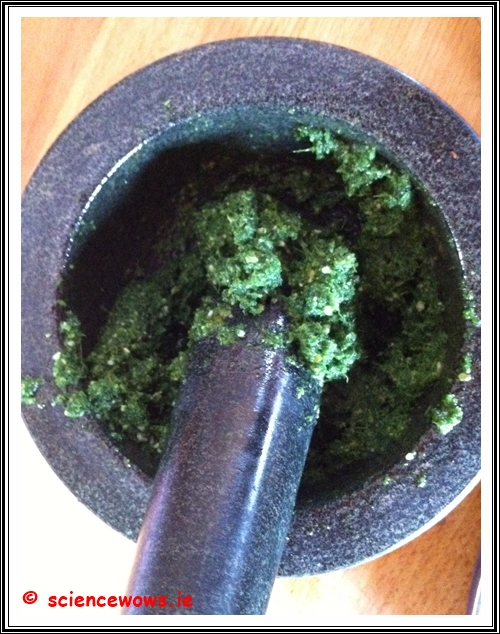
Summer is here, the temperatures are lifting and everything green is bursting forth…. including the nettles! Don’t despair though, behind the sting lies a very useful and beneficial plant! Young nettles are great as a diuretic, a natural anti-inflammatory (used for allergies, asthma, rheumatism) and to treat high blood pressure… to name but a few benefits!
Inspired by this years emerging crop we decided to make some nettle pesto; Usually when I make it I tend to throw in ingredients according to my taste preferences but for the purpose of this blog post I handled things a bit more scientifically and weighed out the ingredients. Feel free to change them at will of course, it is very much a recipe to be “personalized”!
First up…. harvest your nettles, even better if you can recruit a helper or two, this was my “helper” for the task – gloves, hat and all!

Wearing our nettle protecting gloves we headed out into the back garden and collected a large basin full of lovely nettles (harvesting the top two to three bracts)…

Next I removed the leaves and washed them, ending up with a colander full!

Next step was to blanch the nettle leaves, so they were added to a large pot of boiling water for two minutes then removed with a slotted spoon and added to iced water.


Then I placed all the nettles into a clean tea towel and squeeze out the water until the nettles were fairly dry
This left me with 100 g nettles, I was ready to make my pesto!
My ingredients…

100 g preped nettles
50 g pinenuts
Juice and zest of one lemon
150 mls olive oil
30 g parmesan cheese
1 clove of garlic
Sea salt to taste
Pepper to taste
All that remained was to add all the ingredients together and blend, blitz or pound them to the preferred consistency.

I got about 250 g of pesto from this, nicely filling four 150 ml bottles…

Guess what we are having for dinner this evening?
Update August 2015:
I am adding this post to the #FreeFromFridays Link up, hosted this week by Dairy Free Kids. Click on the link below for lots of great Free From recipes…
Further reading:
Stinging nettle pesto recipe
Nettle pesto recipe
Latest science on Rooibos and Nettle Tea
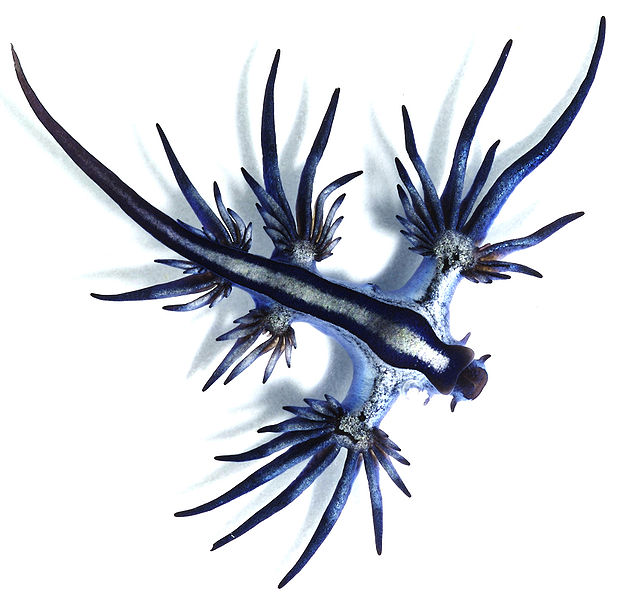
May 6th – 12th 2013
Well did you guess what this week’s creature was? For those of you who had it just on the tips of your tongue … let me put you out of your misery… its a Blue Sea Slug, also known as a sea swallow or a sea dragon!

Blue sea slugs float on their backs on the top of the sea, so the beautiful blue colours we see are actually the underside (foot) of the creature. Their backs, submerged in the water, are actually a silvery-grey colour. They are able to float due to a large sac in their stomach which they fill with air.It’s official name is a Glaucus atlanticus and it is a nudibranch (a shell less* mollusck). These little creatures usually only reach about three to four cm in size but don’t let that fool you…. they have a mean sting! The blue sea slug preys on larger toxic sea dwellers such as the Portuguese Man O’ War (Physalia physalis). It is immune to the stinging cells (nematocytes) within these creatures and is also capable of storing these deadly toxins within its own body and using them for its own defense. The more venom it accumulates the deadlier its sting!
*Nudibranches may have shells during early stages of development but are shell less when fully mature).
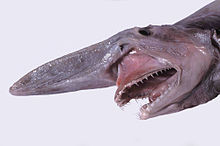
Week: 29th April – 5th May 2013
Only a few correct answers to this weeks mystery creature…. it is the GOBLIN SHARK.

The goblin shark (Mitsukurina owstoni) is another deep sea dweller and is often referred to as a living fossil as its lineage can be traced back 125 million years. It is unique among sharks with its unusual protruding snout and extendable jaw. The colour of these sharks ranges from pinkish grey to a deep pink. Its muscle tone is weak and it is thought to be a poor swimmer. It uses electric field receptors within its snout to detect its food, mainly crustaceans, cephalopods and certain deep sea fish. Goblin sharks typically grow to two to three metres in length, with the females thought to be the larger of the sexes.
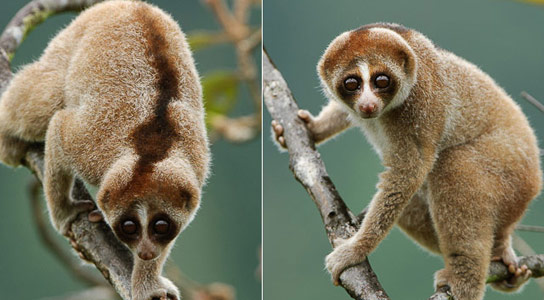
Week: 22nd – 28th April 2013
How did you get on with this weeks CAN YOU NAME THIS CREATURE? Did you guess it? Got a fair few correct answers from people; It is a Kayan slow loris!!!
 |
| Image credit: Ch’ien C. Lee |
The slow loris is a close relative of the lemur and can be found in South east Asia.
These cute looking animals are listed as endangered and have been coveted as pets; not only do they not make good pets but they are also rare among primates in that they have a poisonous bite…. so their teeth are often removed as they are passed into the pet trade. They often die of infection from such mishandling!
The slow loris is recognised by it’s large eyes, distinctive fur markings and lack of tail. The Kayan slow loris was only recognised as a distinct species of slow loris is 2012 when more detailed recording of markings and features where recorded among the slow loris of Borneo.
Stay tuned for a new CAN YOU NAME THIS CREATURE post tomorrow!
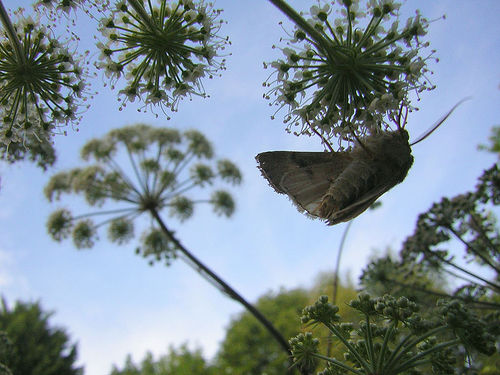
Well it is official… Spring is here for sure… the Cuckoo was heard from our garden yesterday, not by me I’m afraid, not yet anyway, but it definitely marks the ticking of nature’s clock, the passing of the seasons. The cuckoo is calling, tick that box, all is well with the world!
I have to admit I love the anticipation of each seasonal landmark. The first snowdrop, the arrival of the golden daffodils, the synchronous timing of the budding of each tree, like a perfectly tuned orchestra, each player patiently awaiting it’s moment and joining the symphony at exactly the correct point in time.

My children have lived in this house all their young lives and I am charmed to see them remarking on these natural milestones too. They begin to remember their own landmarks of the passing of the seasons and ask me when a certain one will arrive. These things they have learned on their own… or more precisely, Mother Nature has taught them, tapping them gently on the shoulder to anchor the arrival of each new marvel.
We are lucky to live in the country where nature so beautifully illustrates the passage of the seasons. The hedgerow by our house, each plant revealing another milestone. A natural metronome tapping out the appearance of each… the colts foot, lesser celandine, cowslips, dandelions, herb roberts, speed-well, the flowering gorse, bird’s foot trefoil, angelica, meadow sweet, valerian. As one disappears another arrives and there is a feeling of familiarity and contentment in seeing an old friend emerging once again. Each a lovely reminder of our early years in this house, before we had children, when my husband and I would walk the lane together and he would point out the arrival of each new plant, teaching me it’s name. Now every time I see a familiar arrival I remember that special time.
….just a thought!
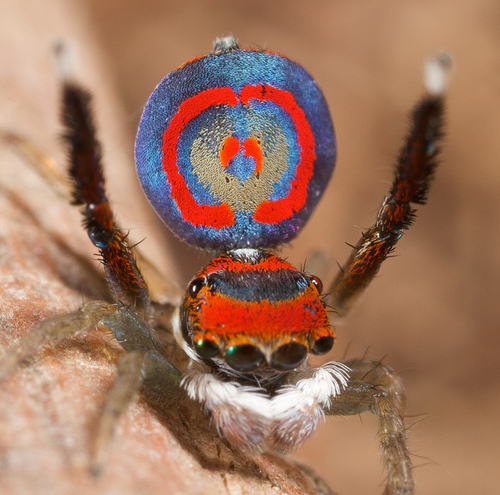
Week 15th – 22nd April
Did you guess this weeks CAN YOU NAME THIS CREATURE? It is a PEACOCK SPIDER!! Well done to Michael from Nature Learn and to Sonja Koprek for getting it right!

What is not apparent from the photo above is the size of these spiders, they are tiny, growing to no bigger than 5mm! It is only the males that have this splendidly coloured stomach flap… the females are brown in colour with black markings. When the male spots a female it raises it’s legs and flashes it’s brightly coloured flap in an unusual dance like sequence…. a spectacular mating ritual!There are about 20 know species of peacock spiders but less than half of them have been formally identified! This one is the Coastal Peacock spider (Maratus specious). Peacock spiders are found in south eastern Australia they are also know as gliding spiders and are a type of jumping spider.
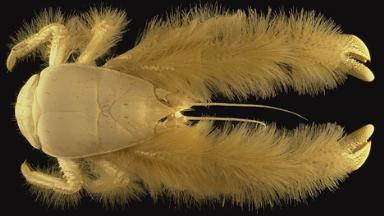
Week 8th – 14th April
Did you manage to guess last weeks CAN YOU NAME THIS CREATURE? …. I got two correct answers… from Dave at The Wedding Artist and from Michael at Nature Learn; Well done because it was a tricky one I thought.
So what was it? It was a YETI CRAB (Kiwa hirsuta)… a deep sea crustacean newly discovered in 2005.



So there you have it, these are some of my thoughts on the subject. I am not suggesting that any of these points are backed up with scientific findings…. the are just the random thoughts of this simple scientist! Maybe you have your own theories to add?